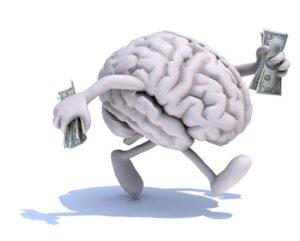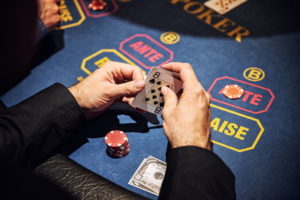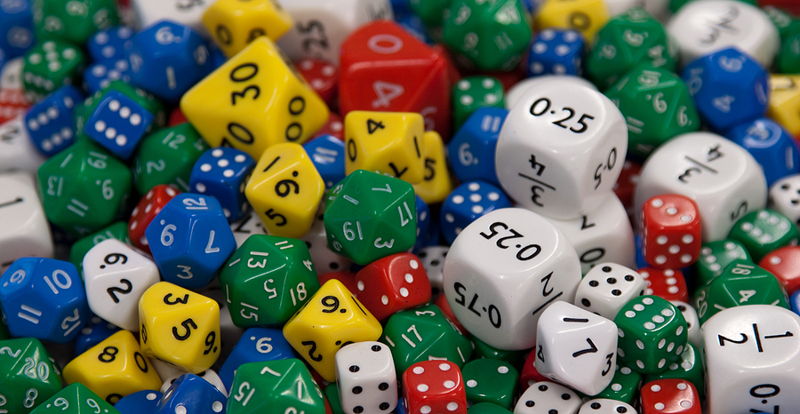 Estimating the odds of the various events in gambling is part of both objective strategies of playing and a responsible-gambling attitude. But such math work is not at everybody’s hand and requires time to be completed, which we don’t have during a live game.
Estimating the odds of the various events in gambling is part of both objective strategies of playing and a responsible-gambling attitude. But such math work is not at everybody’s hand and requires time to be completed, which we don’t have during a live game.
In this article we will see what options are for specific computing techniques to be applied for odds estimation during gambling, what skills are required for that, and in which games we can benefit mostly of such skills.
Estimating odds and the importance of gambling-math skills
 Knowing the math behind the gambling games is recognised as an important skill factor for some games. Those mastering the mathematical knowledge and computation in gambling have access to using objective strategies that may turn them into successful players.
Knowing the math behind the gambling games is recognised as an important skill factor for some games. Those mastering the mathematical knowledge and computation in gambling have access to using objective strategies that may turn them into successful players.
The most relevant example in this respect is poker, where the most popular winners are constant winners and this constancy is just the result of using their mathematical skills (along with other skills, like reading opponents) when estimating their card odds during the game. Blackjack is also a traditional game where those skilled in optimal strategy and card counting achieve positive results in the long run.
There is math behind any game of chance and the extent to which a player have a good grasp of it and is skilled in computing statistical indicators (probabilities, expected values, house edge) in the various moments of the game is a measure of its potential success.
Gambling math does not only concern strategy, as there are games for which only subjective strategies or strategies of choosing are available. Gambling math helps players in getting informed about the games they play and their personal strategies, in organising their play, and in all the choices they made. That’s simply because these games are conceived on the basis of mathematical models.
Why estimate odds in gambling?
 The main criterion of being skilled in applying the gambling math in your game is to compute or estimate odds. One may refer to odds in the gambling jargon as house edge or expected value, although the most common meaning of the term is that of probability. It is this latter meaning that we will use in this article.
The main criterion of being skilled in applying the gambling math in your game is to compute or estimate odds. One may refer to odds in the gambling jargon as house edge or expected value, although the most common meaning of the term is that of probability. It is this latter meaning that we will use in this article.
Probability is the core notion of mathematics that grounds statistical indicators such as expected value, house advantage, and statistical averages of all kinds (such as dispersion, standard deviation, or variance).
Probability has a complex mathematical definition elaborated within measure theory, however in the particular case of gambling games, this reverts to a simple one that everyone should know before proceeding to any computation: The probability of an event to occur is the ratio between the number of situations favourable for that event to occur and the total number of equally-possible situations.
Why are the odds important for the gamblers? First, probability of winning a bet is consumer-type information: A gambling product (that is, a bet offered) has its own surplus price added like any other commercial product. This surplus is expressed in terms of odds, more precisely the difference between the payout odds and the true odds (the mathematical probability of winning the bet).
Second, comparison of odds stands as a criterion of choosing a game or a certain action within a game, which of course reverts to using an objective strategy.
Estimating odds quickly and games where this makes a difference?
 Any math or applied-math work requires time and obviously the brevity of your actions in gambling – imposed by the casino rules – does not allow you to do hard computations during the game. The alternative of “doing your homework” before the game by memorising as many as possible numerical odds associated with the various gaming situations is not actually an effective option, at least for some games, where the possible configurations and situations are in the order of tens of thousands or even tens of millions.
Any math or applied-math work requires time and obviously the brevity of your actions in gambling – imposed by the casino rules – does not allow you to do hard computations during the game. The alternative of “doing your homework” before the game by memorising as many as possible numerical odds associated with the various gaming situations is not actually an effective option, at least for some games, where the possible configurations and situations are in the order of tens of thousands or even tens of millions.
Then, is there something to do to improve one’s skills of estimating odds in a short time, in order to apply the information during gambling? Yes, such skills are real and can be improved, but before talking about that we have to ask ourselves in what situations and games are these skills really required and do worth the effort of improving them.
Odds will tell you how likely is for you to win a bet in whatever game, but in static games like roulette, baccarat, craps, or slots, knowing the odds before placing your bet does not change your chances to win it. Instead, in interactive games like poker or blackjack, where actions are required after placing the bet, the various odds at a certain moment will indicate you a certain action.
In other words, estimating and comparing odds is part of a strategy. This is why the skill of estimating odds during the gambling actually applies to these two games. For the rest of the games, any estimation can be done before playing, and may result in specific choices for your bets, including choosing a game or another. Such informed choices are of the greatest importance in roulette.
Types of odds and how to approach them
 In gambling there are several kinds of events that can be measured in probability, depending on the game and how it progresses.
In gambling there are several kinds of events that can be measured in probability, depending on the game and how it progresses.
We have the immediate odds, which are odds of events that occur with the next stage in the game’s progress (for example, the number coming with the spin in roulette, or the next card to be dealt to your hand in blackjack, or the flop configuration in Hold’em after you receive your hole cards, and so on); we have long-shot odds, which are odds of two- or more-steps events (for example, draws with two or more cards to come for your hand or on the board in poker, winning eventually the hand in blackjack, winning a pair side bet in baccarat, and so on).
We also have odds for your own hand and for your opponent’s hands (for games played against opponents, like poker). We have odds for one opponent and odds for any opponent or at least one opponent. There are direct or conditional probabilities. Overall, there are several types of odds and each type may break down in hundreds or thousands of general odds, depending on the game and the moment or stage when the odds are estimated.
Some of these odds are easier to compute manually, others are more difficult and others are actually impossible. We are talking of course about computing them in silence, out of the time pressure.
When we are in the middle of the action and recalling memorised results is not working, the only thing available is to try a quick estimation; however, this have to be objective and as accurate as possible, not by feeling – probability evaluation may be tricky think for those unaware and should be done only by mathematical means.
Probability as a fraction

The very first thing to start with before applying any technique for estimating odds during a game is to remember that classical probability is by definition a fraction: P(A) = n/m.
The numerator n expresses the number of situations favourable for our measured event A and the denominator m the total number of equally-possible situations. Obviously, m is something specific for the given game and stage of the game, and as such can be known as memorised before you are in the game.
Examples:
– If event A refers to a roulette spin, m could be 37 or 38, depending on the roulette version. This is what everybody knows.
– If event A refers to the roll of two dice in craps, then m is 36 (the number of all possible combinations for the outcomes on two dice, 6 x 6 = 36).
– If event A refers to the next card to be dealt to you in a two-deck blackjack game where five cards were already dealt to players, then m is 2 x 52 – 5 = 101, that is, the number of unknown cards. If A refers to the next two cards to be dealt to you in the same conditions, then m is C(101, 2), denoting the number of combinations of 101 cards taken each 2. This is 5,050.
– If event A refers to the flop cards in a Hold’em game where you were dealt your hole cards, then m is C(50, 3), because there are 50 unknown cards and 3 is the number of cards on the flop. This number is 19,600.
The numerator n of the probability fraction is actually what you have to estimate in the quick time at your disposal during the game and is specific for each particular game configuration at the moment of estimation. We shall talk about it in particular games and about the available techniques of computing, estimating or approximating it.
For the moment, let’s start with the end: assume that you have estimated n in a given situation and you know m before the game. You have now your probability fraction.
It is important to note that knowing m before entering the game is a crucial requirement for any quick odds estimation during the game. The time at your disposal (sometimes, a few seconds) is problematic for the estimation of n, and even more so for another estimation, even if easier than the former.
When you are in the lucky situation where you know both n and m, doing the ratio n/m is all that is left for your odds estimation. However, you have to choose what format best suits you for this probability – fraction or percentage. That’s because some people have a better perception of probability as a measure of the possibility of an event happening in a format or another.
If you choose the fraction format, you should convert quickly your fraction to have the numerator 1 (for reading the final result as ‘one in …’ and giving you a clearer image of the measurement). This can be done by forcibly dividing the top and the bottom of the fraction by n (the numerator).
Example:
If P = 3/25, then you forcibly divide by 3 and get P = 1/8.33, so your probability is about 1 in 8.
If you want it as percentage, you have to do additional operations in mind, which will increase the calculation time: Multiply the numerator (n) with 10, 100, 1,000, or whatever power of ten is necessary for n to become higher than m.
Then do the division of the result by m and move the decimal dot back to the left with the number of decimals indicated by the exponent of the power of ten that you multiplied n with. Then read the result as a percentage by multiplying it by 100.
Example:
If P = 9/1,081, first write it with numerator 1: P = 9/1,081 = 1/120.11. Multiply 9 by 1,000 to exceed 1,081 and do the division: 9,000/1,081 = 8.325. Divide back to 1,000 by moving the decimal dot three places: 8.325 : 1,000 = 0.008325. Write it as percentage: 0.008325 = 0.8325%.
Of course, you may approximate the result even from the beginning as 1%, by rounding your fraction to 10/1,000 and this is an effective technique to use when appropriate, as an error range of less than 2% does not change decisions based on odds.
Obviously, expressing your probability fraction as percentage takes far more time than converting it to have the numerator 1 and only those computationally gifted could do that in a few seconds.
We saw what is to do with the probability fraction when you have it. But the real difficulty is to reach that fraction, which adds the longest time for estimation. The degree of this difficulty depends on the game in question and poker is on the top of the list in this respect.
Conclusion
 Studying the math behind the games and memorising as many as possible odds for using them in your game is a difficult task and requires good cognitive assets. Estimating the odds in mind during the game is even harder and only those gifted can acquire such skills.
Studying the math behind the games and memorising as many as possible odds for using them in your game is a difficult task and requires good cognitive assets. Estimating the odds in mind during the game is even harder and only those gifted can acquire such skills.
This cognitive effort would actually worth trying in games of chance where decisions can be made on the basis of odds, as part of objective strategies; these games are blackjack and poker.
About The Author
The author of this page is Dr. Catalin Barboianu. Catalin is a mathematician specialising in gaming and responsible gambling and a research associate at the University of Bucharest.
